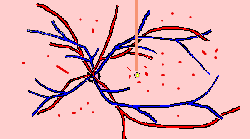Your sight should be perfectly good at this stage. A
doctor examining your eye will notice tiny abnormalities.
Your pupils have to be dilated for this examination, and you are often advised not
to drive until the pupils have returned to their normal size.
The tiny blood vessels in the retina, the capillaries, become damaged. This has been
discussed on the 'Mechanisms of Retinopathy' page.What the
doctor sees
A doctor or optometrist may see 'dots' and 'blots'.
The dots are some capillaries that have enlarged, that is the the
tiny blood vessels enlarge to form microaneurysms.
The blots are tiny haemorrhages, that is tiny spots of blood, on the
surface of the retina.
What does it mean if you have 'background retinopathy'?
The number of microaneurysms, the little red dots the doctor sees,
indicate the likelihood of more severe problems in the years to come.
Retinopathy develops more slowly if your sugar and blood pressure
etc (PREVENTING PROBLEMS) are controlled. Unfortunately for many
people with diabetes the retinal damage increases, and maculopathy or proliferative
retinopathy develop over a few years. |

This is the view a doctor sees looking
into your eye. The small red dots are 'microaneurysms', tiny damaged capillaries. The red
lines are small haemorrhages, little flecks of blood. Your sight is not affected at this
stage. |